
The orange-headed thrush is a bird in the thrush family.

The hooded warbler is a New World warbler. It breeds in eastern North America and across the eastern United States and into southernmost Canada (Ontario). It is migratory, wintering in Central America and the West Indies. Hooded warblers are very rare vagrants to western Europe.

Clivia miniata is a species of flowering plant in the genus Clivia of the family Amaryllidaceae, native, growing in woodland habitats in South Africa as well as in Swaziland. Given suitable conditions it grows into large clumps and is surprisingly water wise. It is also reportedly naturalized in Mexico. It is a popular plant for shady areas and is commonly seen growing in older established suburbs in most Australian states. It is also popular in New Zealand, Japan, China and the USA, particularly California.

Known as the false death cap, or Citron Amanita, Amanita citrina, is a basidiomycotic mushroom, one of many in the genus Amanita. It grows in silicate soil in the summer and autumn months. It bears a pale yellow or sometimes white cap, with white stem, ring and volva. Though it is not poisonous, its similarity to the lethal death cap precludes its use in cooking.

The stripe-tailed yellow finch is a species of bird in the family Thraupidae. It is found in Argentina, Bolivia, Brazil, Colombia, Guyana, Paraguay, Peru, Suriname, and Venezuela. Its natural habitats are dry savanna and pastureland.
Partula citrina was a species of air-breathing tropical land snail, a terrestrial pulmonate gastropod mollusk in the family Partulidae. This species was endemic to French Polynesia. It is now extinct.
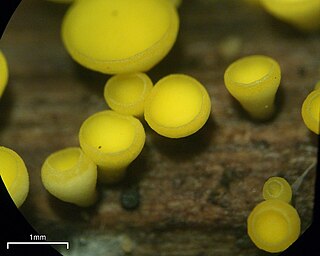
Bisporella citrina, commonly known as yellow fairy cups or lemon discos, is a species of fungus in the family Helotiaceae. The fungus produces tiny yellow cups up to 3 mm (0.12 in) in diameter, often without stalks, that fruit in groups or dense clusters on decaying deciduous wood that has lost its bark. The widely distributed species is found in North Africa, Asia, Europe, North America, and Central and South America. Found in late summer and autumn, the fungus is fairly common, but is easily overlooked owing to its small size. There are several similar species that can in most cases be distinguished by differences in color, morphology, or substrate. Microscopically, B. citrina can be distinguished from these lookalikes by its elliptical spores, which have a central partition, and an oil drop at each end.
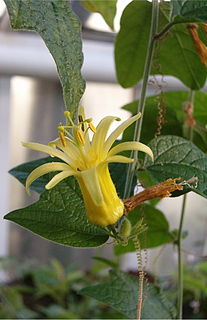
Passiflora citrina is a species of passion flower (Passiflora) native to Central America. It is also grown as an ornamental plant.
Naria citrina, common name the orange cowrie, is a species of sea snail, a cowry, a marine gastropod mollusk in the family Cypraeidae, the cowries.
Mylothris citrina is a butterfly in the family Pieridae. It is found in Uganda, the Democratic Republic of Congo and Tanzania. The habitat consists of forests.
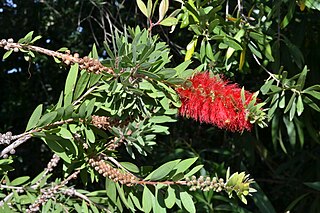
Melaleuca citrina, commonly known as common red, crimson or lemon bottlebrush, is a plant in the myrtle family, Myrtaceae and is endemic to New South Wales and Victoria in Australia. It is a hardy and adaptable species, common in its natural habitat. It is widely cultivated, not only in Australia, often as a species of Callistemon. It was one of the first Australian plants to be grown outside the country, having been taken to England in 1770 by Joseph Banks. Its showy red flower spikes, present over most of the year in an ideal situation, account for its popularity.

Hemerocallis citrina, common names citron daylily and long yellow daylily, is a species of herbaceous perennial plant in the family Asphodelaceae.

Sybra is a genus of beetles in the family Cerambycidae, containing the following species:
Molgula citrina is a species of solitary tunicate in the family Molgulidae. It is found on both sides of the northern Atlantic Ocean and in the Arctic Ocean. In 2008 it was found in Kachemak Bay in Alaska, the first time it had been detected in the Pacific Ocean.

Sybra umbratica is a species of beetle in the family Cerambycidae. It was described by Pascoe in 1865.

Sybra ordinata is a species of beetle in the family Cerambycidae. It was described by Bates in 1873.
Sybra pascoei is a species of beetle in the family Cerambycidae. It was described by Lameere in 1893.
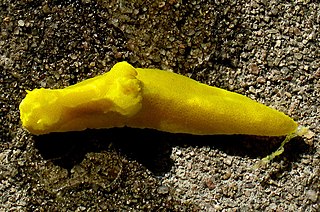
Notodoris citrina is a species of sea slug. It is a dorid nudibranch, a shell-less marine gastropod mollusc in the family Aegiridae.
Caladenia citrina, commonly known as the Margaret River spider orchid, is a plant in the orchid family Orchidaceae and is endemic to the south-west of Western Australia. It has a single erect, hairy leaf and up to three lemon-yellow flowers. It has a narrow distribution in the far south-west corner of Western Australia.
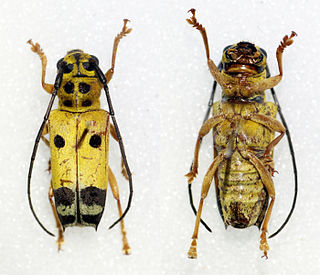
Glenea citrina is a species of beetle in the family Cerambycidae. It was described by James Thomson in 1865. It is known from Laos, Java, Borneo, Malaysia, and Sumatra.















